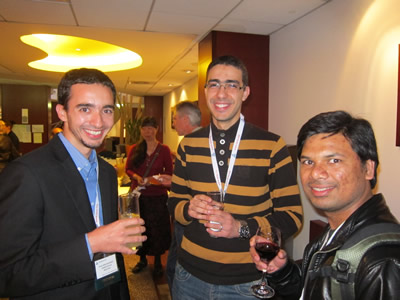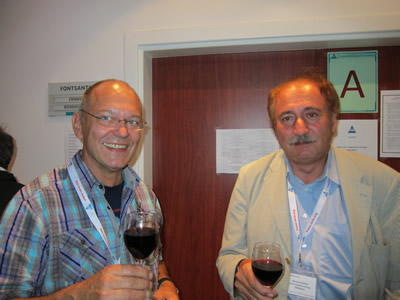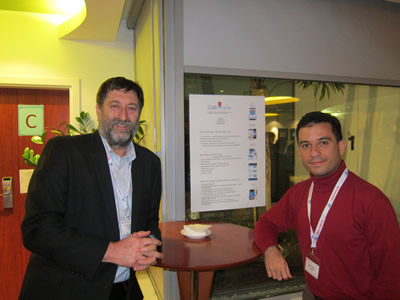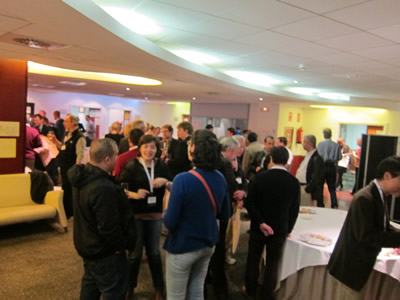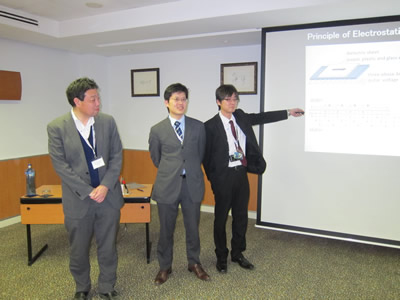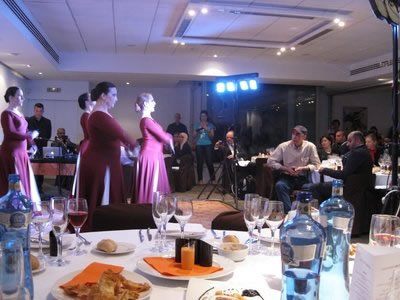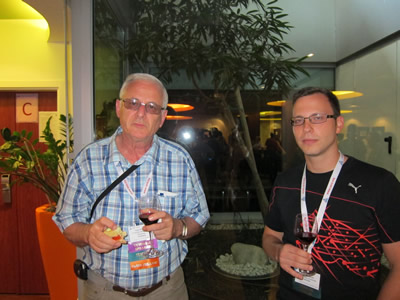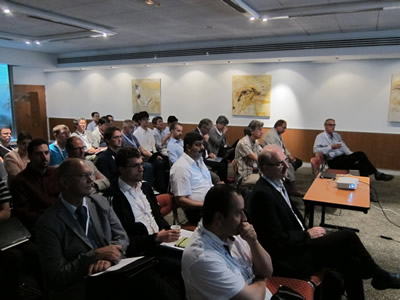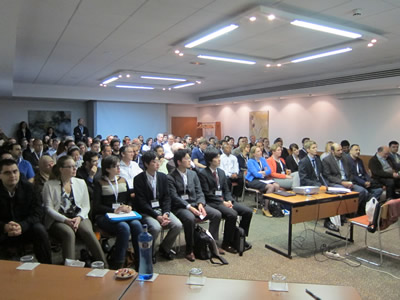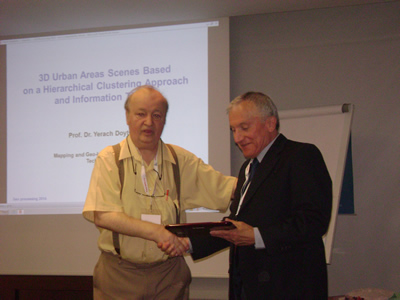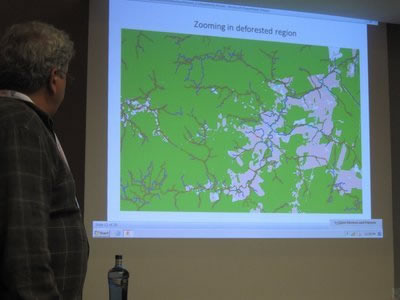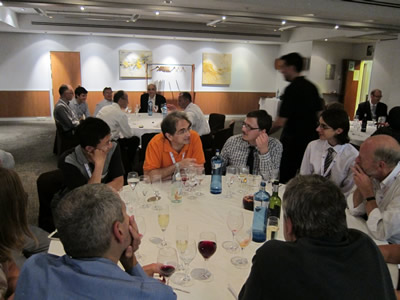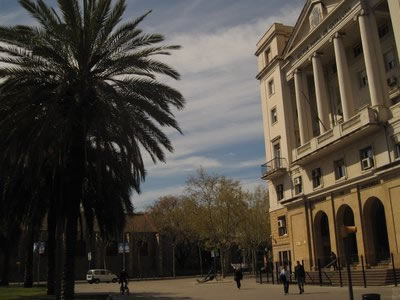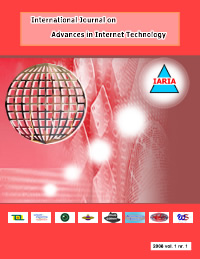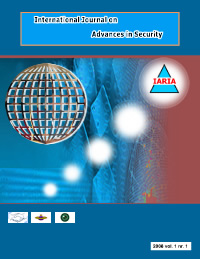INTERNET 2023 - The Fifteenth International Conference on Evolving Internet
March 13, 2023 - March 17, 2023
INTERNET 2023: Call for Papers
Onsite and Online Options: To accommodate a large number of situations, we are offering the option for either physical presence or virtual participation (pdf slides or pre-recorded videos).
Originally designed in the spirit of interchange between scientists, Internet reached a status where large-scale technical limitations impose rethinking its fundamentals. This refers to design aspects (flexibility, scalability, etc.), technical aspects (networking, routing, traffic, address limitation, etc), as well as economics (new business models, cost sharing, ownership, etc.). Evolving Internet poses architectural, design, and deployment challenges in terms of performance prediction, monitoring and control, admission control, extendibility, stability, resilience, delay-tolerance, and interworking with the existing infrastructures or with specialized networks.
The INTERNET 2023 conference deals with challenges raised by evolving Internet making use of the progress in different advanced mechanisms and theoretical foundations. The gap analysis aims at mechanisms and features concerning the Internet itself, as well as special applications for software defined radio networks, wireless networks, sensor networks, or Internet data streaming and mining.
While many attempts are done and scientific events are scheduled to deal with rethinking the Internet architecture, communication protocols, and its flexibility, the current series of events starting with INTERNET 2009 is targeting network calculi and supporting mechanisms for these challenging issues.
We solicit both academic, research, and industrial contributions. We welcome technical papers presenting research and practical results, position papers addressing the pros and cons of specific proposals, such as those being discussed in the standard fora or in industry consortia, survey papers addressing the key problems and solutions on any of the above topics short papers on work in progress, and panel proposals.
Industrial presentations are not subject to the format and content constraints of regular submissions. We expect short and long presentations that express industrial position and status.
Tutorials on specific related topics and panels on challenging areas are encouraged.
The topics suggested by the conference can be discussed in term of concepts, state of the art, research, standards, implementations, running experiments, applications, and industrial case studies. Authors are invited to submit complete unpublished papers, which are not under review in any other conference or journal in the following, but not limited to, topic areas.
All topics and submission formats are open to both research and industry contributions.
INTERNET 2023 conference tracks:
Hot topics in Internet
From Internet of Thinks (IoT) to Internet of People (IoP) and Internet of Everything (IoE); Improving reliability; Congestion-adaptive data collection; Accuracy in cyber-physical systems; Internet and home environments; Fog computing in industrial IoT-context; Mobile Edge Computing (MEC); Cloud-based: networking (NaaS), multimedia (MaaS), videogames (VaaS); LTE broadcasting; Identity-oriented networks; Selectivity-aware MU-MIMO for wideband WiFi; mmWave networks and technologies; Deadline-sensitive opportunistic utility-based protocols; Social sensing applications; Opportunistic smartphone sensing; Delay-tolerant IoT; IoP and Smart cities; Multi-vendor NVF (Network Virtual Functionalities) orchestration; SDN (Software Defined Network)--based resilience; Policy-based NFV management; Performance of SDN controllers; Performance optimization for NFV; SDN Access control; 5G Edge caching techniques; Performance in 5G networks; Security and privacy in data-centers; Identity and privacy management; QoS (Quality of Service) and QoE (Quality of Experience); Standardization efforts (MEC, mmWave, SDN, NFV, 5G, etc.)
New Internet Challenges
SDN, SDX, NFV; 4G/5G and advanced mobile Internet; Internet of X (everything, things, people, etc.); Internet, Virtualization and Cloud; Internet and Big Data; Sensing and sensor networks; Energy-aware networks; Content-oriented networking; Cellular cognitive networks; Future routing mechanisms
Future Internet Architecture
Architectures for the Internet of Things; Web of Things; Web of Things and Semantic; Internet of Things and Clouds internetworking; Network media, content and service orientation; Embedded Web Services (CoAP / Lightweight SOAP); Mobility and Future Internet; Pervasive Internet of Things; User-oriented, context-aware Internet of Things services; Location and discovery of things on the Internet; Crowd-sourcing and things; Trust, security and privacy in Internet of Things; Lightweight implementations of cryptographic stacks; Experiences with Open Platforms and hardware within Internet of Things; Internet of Vehicle (IOV)
Advanced Internet mechanisms
Access: call admission control vs. QoE vs. structural QoS / capability-based access control vs. role-based access control vs. attribute-based access control; Routing and pricing models: BGP, pricing peering agreements using microeconomics, topological routing vs. table-based routing vs. network coding, power-efficient routing; Optimization in P2P/CDN networks: peer placement for streaming P2P, analysis of P2P networks; Traffic engineering: estimating traffic matrices, constrained routing, exponentially bounded burstness; Behavioral traffic recognition: identifying applications from traffic behavior; Traffic analysis: methods for analysis and visualization of multidimensional measurements, characterizing protocols; Software defined radio networks: low power signal processing methods, applications of machine learning; Cognitive radio: medium access, spatiotemporality, complexity, spectrum sharing and leasing, channel selection, multi-stage pricing, cyclostationary signatures, frame synchronization; Streaming video: learning from video, techniques for in-network modulation, adaptive video streaming; Location: statistical location, partial measurements, delay estimation
Graph theory/topology/routing Internet support
Information theory: distributed network coding, Shannon's entropy, Nash equilibrium; Optimization: LP, NLP, NeuroP, quadratic, convex programming, compressed sensing; Graph theory: random graphs, spectra graph theory, percolations and phase transitions, methods from statistical physics, geometric random graphs; Algebraic techniques: tensor analysis, matrix decomposition; Processing: signal processing techniques, equalization, point-process, source coding vs. network coding, recoverability; Statistical machine learning: probabilistic graphical models, classification, clustering, regression, classification, neural networks, support vector machines, decision forests; Game Theory/Microeconomic theory: social choice theory, equilibria, arbitrage and incentive oriented distributed mechanism design, cooperative games, and games on graphs; Stochastic network calculus; Fractal behavior and stability mechanisms; Kolmogorov complexity for performance evaluation; Complexity theory
Internet security mechanisms
Cryptography: design and analysis of cryptographic algorithms, applied cryptography, cryptographic protocols and functions; Specification, validation design of security and dependability: security and trust models, semantics and computational models for security and trust, business models in security management, security policies models, security architectures, formal methods for verification and certification, multi-level security specification; Vulnerabilities, attacks and risks: methods of detection, analysis, prevention, intrusion detection, tolerance, response and prevention, attacks and prevention of on-line fraud, denial of services attacks and prevention methods; Access Control: authentication and non-repudiation, accounting and audit, anonymity and pseudonymity; identity and trust management, biometric methods; Anti-malware techniques: detection, analysis, prevention; Cyber-crime response: anti-phishing, anti-spam, anti-fraud methods
Internet trust, security, and dependability levels
Network and transport level security; Network edge security controls: firewalls, packet filters, application gateways; Wireless and mobile network security: risks of wireless insecurity, wireless vulnerabilities and intrusion detection, WLAN and WMAN MAC layer security technologies, key management mechanisms and protocols, security in ad hoc, sensor, mesh and personal communication networks; Security of Internet protocols: routing security, naming, network management, signaling security, transport layer security; Network security policies: specification, implementation, deployment and management; Security of P2P and overlay/middleware systems; Security for multiple domains, large-scale systems and critical infrastructures; Applications and high level services security: Web-based applications and services, VoIP, multimedia streaming services, VoD and IPTV, collaborative applications (conferencing), electronic commerce and eBusiness, eVoting, grid computing, security of eGovernment; Intellectual property protection: digital rights management, licensing, metering, watermarking, information hiding, implementations; Security services integration in complex architectures; Tradeoffs between security and efficiency, usability, reliability and cost.
Internet performance
Performance degradation and anomaly detection mechanisms; User-oriented performance metrics; Network and service provider-oriented performance metrics; Hybrid (chip and network) performance calculi; Intrusive and non-intrusive performance measurement mechanisms; Mechanisms for performance degradation-tolerant applications; Mechanisms for application performance and network performance; Performance enhancement mechanisms; Performance and traffic entropy algorithms; Performance prediction algorithms
Internet AQM/QoS
Buffer sizing, majorization, QoS routing, finite buffer queue vs. infinite buffer queue and performance; Control theoretic framework for modeling of TCP and AQM schemes; Discrete mathematics to model buffer occupancy at queues of a network (given workloads); Game theoretic modeling of AQMs (mathematics to model selfish traffic); Fairness models (proportional fairness, max-min fairness, low state global fairness); Optimization framework for congestion control, fairness and utility maximization; Modeling and simulation of large network scenarios using queuing theory
Internet monitoring and control
Visualization mechanisms; Sub-network/device isolation mechanisms; Control feedback mechanisms (limited feedback, delay and disruption tolerance, optimal and adaptive feedback); Optimal control; Adaptive behavior control; Network resiliency; Self-adaptable and tunable performance; Mechanisms for anticipative measurements and control
Internet and wireless
Capacity of wireless networks; Potential based routing; Algebraic techniques to mine patterns from wireless networks; QoS/QoE translation; Wireless ad hoc / mesh networks: MAC protocols, routing, congestion control, P2P CDNs on wireless meshes
Internet and data streaming/mining algorithms
Mathematics for clustering massive data streams; Randomized algorithms etc and impossibility results; Dimension reduction in metric spaces; Tensor and multidimensional algebraic techniques; Non linear dimension reduction; Optimal collector positioning; Data fusion and correlation algorithms
Internet and sensor-oriented networks/algorithms
Optimal sensor placement; Inference models for sensing; Congestion control; Resource allocation; Mathematics to model different diffusion processes and applications to routing; Algorithms for data fusion; Algorithms for computing dormant/active sending periods; Energy-driven adaptive communication protocols
Internet challenges
Future Internet architecture and design; Next generation Internet infrastructure; Internet cross-layer design and optimization; Internet security enforcement and validation; Future cross-Internet computing; Configurable Internet protocols; Internet-scale overlay content hosting; Internet citizen-centric services; End-user customizable Internet; Mobile Internet; Internet imaging; Internet coding; Internet resilience; Internet QoS/QoE; Context-aware, ambient, and adaptive Internet; Virtualization and Internet; Privacy Enhancing Technologies - PETs
Access networks
Next generation access technologies; Femtocells-based access; Broadband wireless Internet access; Optical access networks; Mobile wireless access; Dynamic and cognitive access; Hybrid optical and wireless access networks; Copper Access; Giga/Tera Access; Access Control; Neutral Access Networks; Legal aspects on network and service access
Deadlines:
Submission | Dec 15, 2022 |
Notification | Jan 23, 2023 |
Registration | Feb 05, 2023 |
Camera ready | Feb 15, 2023 |
Deadlines differ for special tracks. Please consult the conference home page for special tracks Call for Papers (if any).
INSTRUCTION FOR THE AUTHORS
Authors of selected papers will be invited to submit extended versions to one of the IARIA Journals.
Publisher: XPS (Xpert Publishing Services)
Archived: ThinkMindTM Digital Library (free access)
Prints available at Curran Associates, Inc.
How to submit to appropriate indexes.
Only .pdf or .doc files will be accepted for paper submission. All received submissions will be acknowledged via an automated system.
Contribution types
- regular papers [in the proceedings, digital library]
- short papers (work in progress) [in the proceedings, digital library]
- ideas: two pages [in the proceedings, digital library]
- extended abstracts: two pages [in the proceedings, digital library]
- posters: two pages [in the proceedings, digital library]
- posters: slide only [slide-deck posted on www.iaria.org]
- presentations: slide only [slide-deck posted on www.iaria.org]
- demos: two pages [posted on www.iaria.org]
FORMATS
Only .pdf or .doc files will be accepted for paper submission. All received submissions will be acknowledged via an automated system.
Final author manuscripts will be 8.5" x 11", not exceeding 6 pages; max 4 extra pages allowed at additional cost.
Helpful information for paper formatting for MS Word can be found here.
There is a community provided LaTeX template: the CTAN package iaria (with full IARIA formatting rules, including IARIA citation style, but for providing citation style it is tightly bound to pdflatex+biblatex+biber). In addition, there is also iaria-lite (not bound to pdflatex+biblatex+biber, but compatible with any TeX stack; thus, it cannot provide the IARIA citation formattings, but only the titlepage and content-related IARIA formatting rules). Based on the iaria package, there is a minimal working example as Overleaf template. When you are using the LaTeX templates, please still adhere to the additional editorial rules.
Slides-based contributions can use the corporate/university format and style.
Your paper should also comply with the additional editorial rules.
Once you receive the notification of contribution acceptance, you will be provided by the publisher an online author kit with all the steps an author needs to follow to submit the final version. The author kits URL will be included in the letter of acceptance.
We would recommend that you should not use too many extra pages, even if you can afford the extra fees. No more than 2 contributions per event are recommended, as each contribution must be separately registered and paid for. At least one author of each accepted paper must register to ensure that the paper will be included in the conference proceedings and in the digital library, or posted on the www.iaria.org (for slide-based contributions).
CONTRIBUTION TYPE
Regular Papers (up to 6-10 page article -6 pages covered the by regular registration; max 4 extra pages allowed at additional cost- ) (oral presentation)
These contributions could be academic or industrial research, survey, white, implementation-oriented, architecture-oriented, white papers, etc. They will be included in the proceedings, posted in the free-access ThinkMind digital library and sent for indexing. Please submit the contributions following the instructions for the regular submissions using the "Submit a Paper" button and selecting the appropriate contribution type. 12-14 presentation slides are suggested.
Short papers (work in progress) (up to 4 pages long) (oral presentation)
Work-in-progress contributions are welcome. These contributions represent partial achievements of longer-term projects. They could be academic or industrial research, survey, white, implementation-oriented, architecture-oriented, white papers, etc. Please submit the contributions following the instructions for the regular submissions using the "Submit a Paper" button and selecting the contribution type as work in progress. Contributors must follow the conference deadlines, describing early research and novel skeleton ideas in the areas of the conference topics. The work will be published in the conference proceedings, posted in the free-access ThinkMind digital library and sent for indexing. For more details, see the Work in Progress explanation page. 12-14 presentation slides are suggested.
Ideas contributions (2 pages long) (oral presentation)
This category is dedicated to new ideas in their very early stage. Idea contributions are expression of yet to be developed approaches, with pros/cons, not yet consolidated. Ideas contributions are intended for a debate and audience feedback. Please submit the contributions following the instructions for the regular submissions using the "Submit a Paper" button and selecting the contribution type as Idea. Contributors must follow the conference deadlines, describing early research and novel skeleton ideas in the areas of the conference topics. The work will be published in the conference proceedings, posted in the free-access ThinkMind digital library and sent for indexing. For more details, see the Ideas explanation page. 12-14 presentation slides are suggested.
Extended abstracts (2 pages long) (oral presentation)
Extended abstracts summarize a long potential publication with noticeable results. It is intended for sharing yet to be written, or further on intended for a journal publication. Please submit the contributions following the instructions for the regular submissions using the "Submit a Paper" button and selecting the contribution type as Extended abstract. Contributors must follow the conference deadlines, describing early research and novel skeleton ideas in the areas of the conference topics. The work will be published in the conference proceedings, posted in the free-access ThinkMind digital library and sent for indexing. 12-14 presentation slides are suggested.
Posters (paper-based, two pages long) (oral presentation)
Posters are intended for ongoing research projects, concrete realizations, or industrial applications/projects presentations. The poster may be presented during sessions reserved for posters, or mixed with presentation of articles of similar topic. A two-page paper summarizes a presentation intended to be a POSTER. This allows an author to summarize a series of results and expose them via a big number of figures, graphics and tables. Please submit the contributions following the instructions for the regular submissions using the "Submit a Paper" button and selecting the contribution type as Poster Two Pages. Contributors must follow the conference deadlines, describing early research and novel skeleton ideas in the areas of the conference topics. The work will be published in the conference proceedings, posted in the free-access ThinkMind digital library and sent for indexing. 8-10 presentation slides are suggested. Also a big Poster is suitable, used for live discussions with the attendees, in addition to the oral presentation.
Posters (slide-based, only) (oral presentation)
Posters are intended for ongoing research projects, concrete realizations, or industrial applications/projects presentations. The poster may be presented during sessions reserved for posters, or mixed with presentation of articles of similar topic. The slides must have comprehensive comments. This type of contribution only requires a 8-10 slide-deck. Please submit the contributions following the instructions for the regular submissions using the "Submit a Paper" button and selecting the contribution type as Poster (slide-only). The slide-deck will be posted, post-event, on www.iaria.org.
8-10 presentation slides are suggested. Also a big Poster is suitable, used for live discussions with the attendees, additionally to the oral presentation.
Presentations (slide-based, only) (oral presentation)
These contributions represent technical marketing/industrial/business/positioning presentations. This type of contribution only requires a 12-14 slide-deck. Please submit the contributions following the submission instructions by using the "Submit a Paper" button and selecting the contribution type as Presentation (slide-only). The slide-deck will be posted, post-event, on www.iaria.org.
12-14 presentation slides are suggested.
Demos (two pages) [posted on www.iaria.org]
Demos represent special contributions where a tool, an implementation of an application, or a freshly implemented system is presented in its alfa/beta version. It might also be intended for thsoe new application to gather the attendee opinion. A two-page summary for a demo is intended to be. It would be scheduled in special time spots, to ensure a maximum attendance from the participants. Please submit the contributions following the submission instructions by using the "Submit a Paper" button and selecting the contribution type as Demos. The Demos paper will be posted, post-event, on www.iaria.org.
Tutorial proposals
Tutorials provide overviews of current high interest topics. Proposals should be for 2-3 hour long. Proposals must contain the title, the summary of the content, and the biography of the presenter(s). The tutorial slide decks will be posted on the IARIA site.
Please send your proposals to tutorial proposal
Panel proposals
The organizers encourage scientists and industry leaders to organize dedicated panels dealing with controversial and challenging topics and paradigms. Panel moderators are asked to identify their guests and manage that their appropriate talk supports timely reach our deadlines. Moderators must specifically submit an official proposal, indicating their background, panelist names, their affiliation, the topic of the panel, as well as short biographies. The panel slide deck will be posted on the IARIA site.
Please send your proposals to panel proposal
